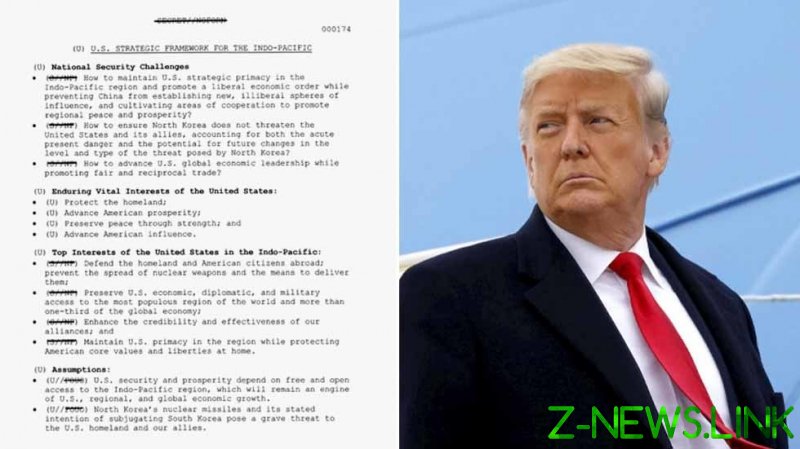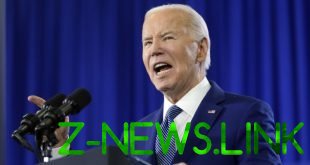
Following the departure of White House Deputy National Security Advisor Matthew Pottinger and with the Trump administration coming to an end, a number of documents have been declassified setting out its ‘Indo-Pacific’ strategy or, more specifically, its gameplan to attempt to contain China over its four years in office.
The documents are hardly comprehensive, yet reveal ambitions to contain Beijing in the political, diplomatic, economic and military spheres, including a blueprint of what the US would do in a potential war scenario.
According to the papers, the US has aimed to sustain its “primacy” in the region, “support activists and reformers” opposed to Beijing (such as the Hong Kong protesters), create a counter to the Belt and Road Initiative (BRI) and economically integrate the region towards the US, enlist allies against China in the form of the Quad and assist “the rise of India”.
But what about in the event of a conflict? The documents spoke of aiming to prevent China “dominating the first island chain” – the scope of islands extending from Japan to Taiwan and around the South China Sea – via air and sea, and to maintain uncontested supremacy over the “area beyond”. Military analysts have described the former objective as being “modest” in expectation.
If anything, the file reveals the comprehensive failure of the Trump administration’s strategy towards the region during his tenure in office. Not only have attempts to bolster America’s economic presence failed completely, largely owing to the contradictory priorities of the White House, but in addition the document illustrates subtle doubt rather than confidence that the US is capable of defeating China in this “first island chain” region.
The US, above all, is seeking naval containment of China, and in line Beijing has utilized the Belt and Road Initiative to counter it by diversifying its energy supply routes.
Throughout its tenure in office, the Trump administration has been unable to accept China’s status as a rising power, and these documents reveal how this resulted in a set of policies aimed at attempting to quell the country’s rise through various means.
These methods, however, have not yielded much success, largely because of the US’s understating of the dynamics which underscore Beijing’s centrality and importance to the region as an economic power, and the erroneous belief that it can easily divide the world into cold war blocs and force countries to undercut their relations with China on the premise of values alone.
The idea that the US can somehow displace Beijing again as the region’s economic centre of gravity is not realistic, and events such as the signing of the Regional Comprehensive Economic Partnership underscore that.
While it is obvious that the economic balance of power is shifting against America, what about in the military sphere? The documents show the US is looking at the region in two distinct areas; that “first island chain” and “the second one”, which constitutes the wider Pacific.
It believes that it should be able to dominate the latter in the event of a war, but can only at best try to prevent China from dominating the former completely, acknowledging that Beijing likely already has the upper hand in the South and East China Seas, and around Taiwan.
Based on this, it seems apparent the US would logically aim to defeat China in such a conflict via an attempt at a naval embargo, given a physical invasion could never be possible. This would involve choking off China’s access to the wider ocean and key maritime points such as the Strait of Malacca.
This strategic planning by the US subsequently sheds light on the BRI. By strengthening infrastructure across the Eurasian landmass, China is diversifying its supply chain routes and reducing reliance on areas that can be dominated by the US Navy.
For example, the China-Pakistan Economic Corridor and Gwadar Port gives Beijing a passage to the western Indian ocean which would bypass US attempts at containment. This has coincided with China’s first overseas military base in the East African country of Djibouti and a port it is working on there, which would be used to protect its interests in this area and thus thwart any US military planning. As the Indo-Pacific strategy has sought to militarize China’s periphery and enlist partners, Beijing has responded.
In this case, the declassified documents reveal the wishlist of a dying administration that has thrown many things at China, with few sticking. It shows the scale of the challenge America faces. Despite the erratic nature of Trump, one should logically expect many of these ideas to be retained and form a template for incoming president, Joe Biden. Objectives such as sustaining US military primacy in Asia and sharpening initiatives such as the Quad will not go away anytime soon, even if there is a substantial lack of realism in them.
Yet the element of doubt in how a conflict with China could be managed only alludes to the shift that is taking place. If America is not confident it could defeat Beijing in the first island chain, then what does that mean for the future? And for Taiwan?
China’s bet in fortifying its presence in the South China Sea, while diversifying its strategic options with the BRI, seems well placed. And that’s why it isn’t Beijing that is fighting an uphill battle to establish a localized dominance on this side of the world.
Like this story? Share it with a friend!
The statements, views and opinions expressed in this column are solely those of the author and do not necessarily represent those of RT.
© 2021, paradox. All rights reserved.





